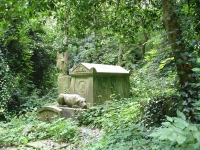Jewett City Vampires
The following article by Megan Baird entitled ‘In 1854, vampire panic struck Connecticut town’ was published in the Register Citizen on 2 November 2008.
GRISWOLD, Conn. (AP) — In May of 1854, the Ray family of Jewett City was frantic.
The large farming family was dying from a devastating disease that caused strong young adults to waste away. Consumption, now known as tuberculosis, was spreading through its ranks with a vengeance.
The family had exhausted traditional means of prevention and were left with one recourse: exhume the bodies of two sons who died from the disease and burn them “on the spot,” as a local newspaper recounted some eight years after the event.
The Rays believed they needed to kill the dead to keep them from feeding on the living.
Last Thursday, state Archaeologist Nicholas Bellantoni and municipal historian Mary Deveau were to take visitors on a walk through history and discuss the plight of the Ray family and what are now known as the Jewett City vampires. The walk was the final stroll sponsored by The Last Green Valley’s Walktober celebration.
“People were frightened. It was a final effort to save the living,” Bellantoni said of the practice.
Griswold and Bellantoni both hold prominent places in what folklorists describe as the New England vampire belief.
In the early 1990s, two boys sliding down a gravel bank in Hopeville dislodged two skulls.
In total, 29 graves were found in the unmarked Walton family cemetery. Bellantoni discovered something strange inside the coffin marked “JB-55.”
The skeletal remains of a man, buried possibly in the 1790s, had been dismembered. His skull had been severed from the spine, turned to face downward and placed in the chest. The two femur bones were positioned in the form of an “X” across the chest just below the skull — skull and crossbones.
JB’s bones had been disrupted roughly five years after he died. Imprints on the bones showed that consumption had ravaged his body. Two nearby bodies, those of IB-46, a woman and NB-13, a child, also died from the disease.
A graduate student in Bellantoni’s research team recalled the story of the “Jewett City vampires,” the Ray family, who lived just 2 miles from the Walton farm.
Researchers believe JB’s bones were rearranged in a desperate effort to prevent him — or stop him — from escaping his grave to feed upon stricken family members.
Rhode Island folklorist Michael Bell, the leading researcher into New England vampires and author of the book “Food for the Dead: On the Trail of New England’s Vampires,” has learned of dozens of incidents of exhumed consumption victims in his 30 years of research.
JB is the only case offering visual confirmation of the practice.
“Right there you have actual physical evidence of the disease along with the evidence of the vampire practice,” Bell said. “Too bad we don’t have more information about JB or the people around him. That’s the problem with so many of these cases.”



Recent Comments